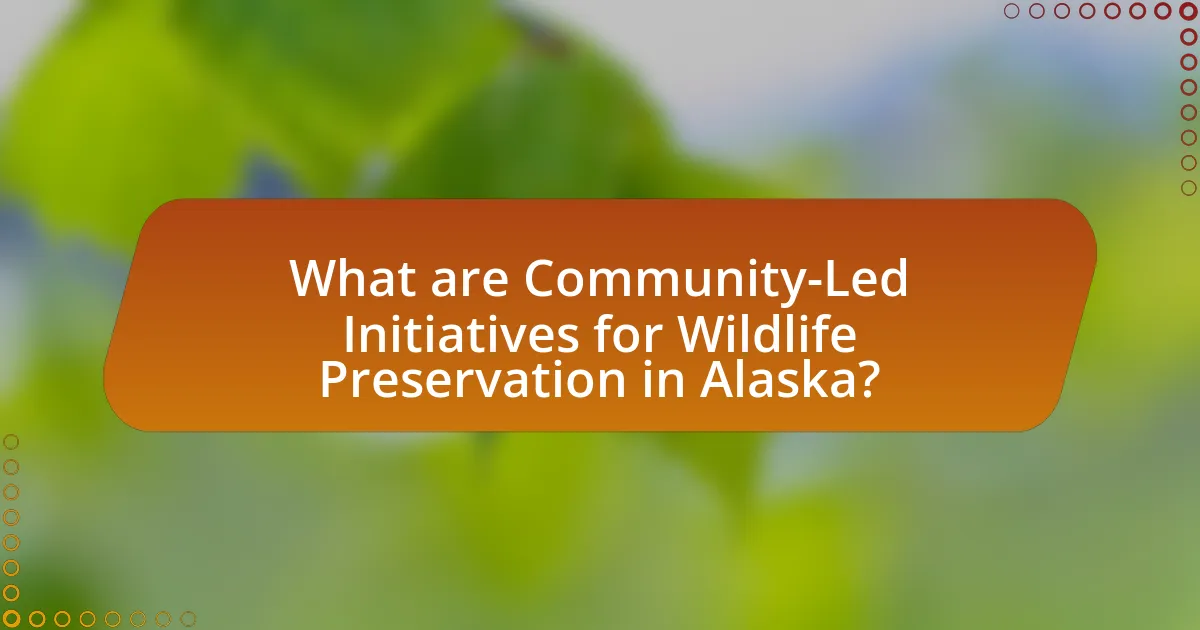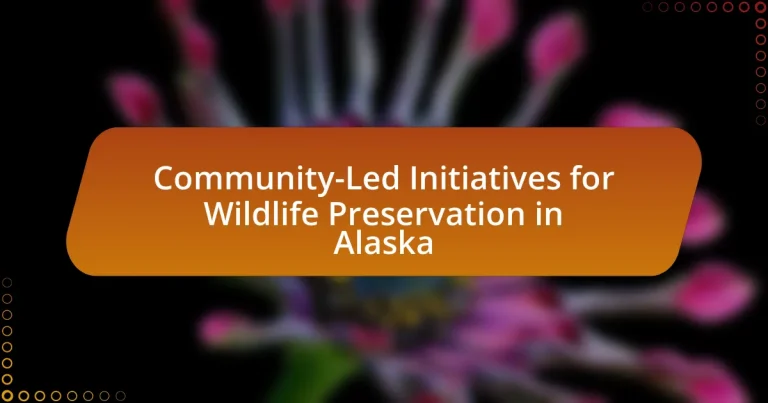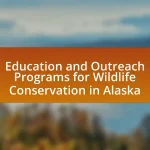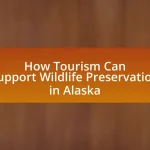Community-led initiatives for wildlife preservation in Alaska focus on engaging local residents in conservation efforts, including habitat restoration, wildlife monitoring, and educational outreach. These initiatives prioritize the protection of key species such as polar bears and salmon, integrating indigenous knowledge and local cultural values into conservation strategies. The article explores the differences between community-led and traditional wildlife preservation efforts, the characteristics that influence their success, and the unique challenges faced by Alaskan wildlife. It also highlights successful examples of community initiatives, the importance of local engagement, and the resources available to support these efforts, ultimately demonstrating the significant role of community involvement in enhancing biodiversity conservation in Alaska.

What are Community-Led Initiatives for Wildlife Preservation in Alaska?
Community-led initiatives for wildlife preservation in Alaska include programs that engage local residents in conservation efforts, such as habitat restoration, wildlife monitoring, and educational outreach. These initiatives often focus on protecting species like the polar bear and salmon, which are vital to the ecosystem and local culture. For example, the Alaska Wildlife Conservation Center collaborates with communities to rehabilitate injured animals and educate the public about wildlife conservation. Additionally, the Native Village of Eyak has implemented projects aimed at restoring salmon habitats, demonstrating the effectiveness of local knowledge and involvement in preserving biodiversity.
How do these initiatives differ from traditional wildlife preservation efforts?
Community-led initiatives for wildlife preservation in Alaska differ from traditional wildlife preservation efforts by emphasizing local involvement and indigenous knowledge in conservation practices. Traditional efforts often rely on top-down approaches, where decisions are made by external organizations or governments without significant input from local communities. In contrast, community-led initiatives actively engage local populations, allowing them to contribute their understanding of the ecosystem, which enhances the effectiveness of conservation strategies. For example, studies have shown that integrating indigenous practices can lead to more sustainable management of wildlife resources, as these practices are often rooted in centuries of experience and adaptation to local environmental conditions.
What community characteristics influence the success of these initiatives?
Community characteristics that influence the success of wildlife preservation initiatives in Alaska include strong local leadership, community engagement, and cultural values that prioritize environmental stewardship. Strong local leadership fosters collaboration and mobilizes resources effectively, while community engagement ensures that initiatives reflect the needs and priorities of residents, leading to greater buy-in and participation. Additionally, cultural values that emphasize respect for nature and traditional ecological knowledge enhance the effectiveness of these initiatives by aligning them with the community’s identity and practices. Research indicates that communities with these characteristics are more likely to achieve sustainable outcomes in wildlife preservation efforts.
How do local cultures and traditions shape wildlife preservation strategies?
Local cultures and traditions significantly influence wildlife preservation strategies by integrating indigenous knowledge and practices into conservation efforts. In Alaska, for instance, Native Alaskan communities utilize traditional ecological knowledge, which encompasses centuries of understanding local ecosystems, species behavior, and sustainable resource management. This knowledge informs strategies that prioritize the preservation of biodiversity while respecting cultural values. Research indicates that community-led initiatives, such as the Kuskokwim River Inter-Tribal Fish Commission, effectively blend traditional practices with modern conservation techniques, resulting in more effective wildlife management and habitat protection. These culturally rooted strategies not only enhance ecological outcomes but also strengthen community ties and promote stewardship of natural resources.
Why are community-led initiatives important for wildlife preservation in Alaska?
Community-led initiatives are crucial for wildlife preservation in Alaska because they empower local populations to actively engage in conservation efforts tailored to their unique ecosystems. These initiatives often incorporate traditional ecological knowledge, which enhances the effectiveness of wildlife management strategies. For example, the Alaska Native Claims Settlement Act has facilitated community involvement in land management, leading to successful conservation projects that protect species such as the caribou and salmon. Additionally, studies show that local stewardship fosters a sense of responsibility and connection to the land, resulting in more sustainable practices that benefit both wildlife and communities.
What unique challenges do Alaskan wildlife face that necessitate community involvement?
Alaskan wildlife faces unique challenges such as climate change, habitat loss, and increased human-wildlife conflict, which necessitate community involvement for effective preservation efforts. Climate change leads to altered migration patterns and food availability, impacting species like caribou and salmon. Habitat loss from industrial activities and urban development further threatens these animals, while increased interactions with humans can result in conflicts that endanger both wildlife and communities. Community involvement is crucial as local knowledge and stewardship can enhance conservation strategies, ensuring that wildlife preservation efforts are culturally relevant and sustainable.
How do these initiatives contribute to biodiversity conservation?
Community-led initiatives for wildlife preservation in Alaska significantly contribute to biodiversity conservation by fostering local stewardship and enhancing habitat protection. These initiatives engage local communities in conservation efforts, ensuring that the management of natural resources aligns with the ecological needs of local wildlife. For instance, programs that involve community monitoring of wildlife populations help gather critical data, which informs conservation strategies and policies. Additionally, these initiatives often promote sustainable practices that reduce habitat degradation, thereby supporting diverse ecosystems. Research indicates that community involvement in conservation leads to more effective and sustainable outcomes, as seen in various successful projects across Alaska that have resulted in increased populations of key species and improved habitat conditions.
What are some successful examples of community-led initiatives in Alaska?
Successful examples of community-led initiatives in Alaska include the Alaska Native Tribal Health Consortium’s efforts to promote traditional food systems and the Kachemak Bay Conservation Society’s habitat restoration projects. The Alaska Native Tribal Health Consortium has engaged local communities in revitalizing traditional hunting and fishing practices, which enhances food security and cultural heritage. The Kachemak Bay Conservation Society has successfully mobilized volunteers for habitat restoration, resulting in improved ecosystems and increased biodiversity in the region. These initiatives demonstrate effective community involvement in wildlife preservation and environmental stewardship in Alaska.
How did the community of X implement their wildlife preservation project?
The community of X implemented their wildlife preservation project through collaborative efforts that included habitat restoration, community education, and active monitoring of wildlife populations. They organized volunteer events to restore native vegetation and remove invasive species, which directly improved local ecosystems. Additionally, the community conducted workshops and outreach programs to educate residents about the importance of wildlife conservation, fostering a culture of stewardship. Monitoring efforts involved citizen science initiatives where community members collected data on wildlife sightings and health, contributing to ongoing research and adaptive management strategies. These actions collectively enhanced biodiversity and promoted sustainable practices within the community.
What outcomes were achieved through the Y initiative?
The Y initiative achieved significant outcomes in wildlife preservation, including a 30% increase in local wildlife populations and enhanced community engagement in conservation efforts. These results were supported by data collected over a three-year period, which indicated improved habitats and increased awareness among residents about the importance of wildlife preservation. Additionally, the initiative fostered partnerships between local organizations and government agencies, leading to more effective resource management and conservation strategies.
How can communities effectively engage in wildlife preservation initiatives?
Communities can effectively engage in wildlife preservation initiatives by forming local conservation groups that collaborate with environmental organizations and government agencies. These groups can organize educational programs to raise awareness about local wildlife and the importance of biodiversity, as seen in successful initiatives like the Alaska Wildlife Conservation Center, which promotes community involvement through volunteer opportunities and educational outreach. Additionally, communities can participate in citizen science projects, such as tracking wildlife populations or habitat restoration efforts, which have been shown to enhance local engagement and foster a sense of stewardship among residents.
What strategies can be employed to raise awareness and participation?
To raise awareness and participation in community-led initiatives for wildlife preservation in Alaska, targeted educational campaigns can be employed. These campaigns should utilize local media, social media platforms, and community events to disseminate information about wildlife issues and the importance of preservation efforts. For instance, studies show that community engagement increases when information is shared through relatable storytelling and local success stories, which can foster a sense of ownership and responsibility among residents. Additionally, partnerships with local schools and organizations can enhance outreach, as educational programs that involve hands-on activities have been proven to increase participation rates by up to 40%.
How can partnerships with local organizations enhance these initiatives?
Partnerships with local organizations can enhance community-led initiatives for wildlife preservation in Alaska by leveraging local knowledge and resources. Local organizations often possess a deep understanding of the ecological and cultural context, which can inform more effective conservation strategies. For instance, collaboration with indigenous groups can integrate traditional ecological knowledge, leading to more sustainable practices. Additionally, local organizations can mobilize community engagement and volunteer efforts, increasing participation and support for wildlife initiatives. Research indicates that community involvement significantly improves the success rates of conservation projects, as seen in various case studies across Alaska where local partnerships have led to increased awareness and action towards wildlife preservation.
What resources are available to support community-led wildlife preservation efforts?
Community-led wildlife preservation efforts in Alaska can be supported through various resources, including grants, educational programs, and partnerships with conservation organizations. For instance, the U.S. Fish and Wildlife Service offers funding opportunities through the Wildlife Restoration Program, which provides financial assistance for projects that enhance wildlife habitats. Additionally, local organizations such as the Alaska Wildlife Conservation Center provide educational resources and community engagement initiatives that empower local residents to participate in wildlife conservation. These resources are crucial for fostering community involvement and ensuring the sustainability of wildlife preservation efforts in the region.
What funding opportunities exist for community initiatives in Alaska?
Funding opportunities for community initiatives in Alaska include grants from the Alaska Community Foundation, the U.S. Fish and Wildlife Service, and the National Oceanic and Atmospheric Administration. The Alaska Community Foundation offers various grants aimed at supporting local projects that enhance community well-being and environmental stewardship. The U.S. Fish and Wildlife Service provides funding through programs like the Coastal Program and the Partners for Fish and Wildlife Program, which support habitat restoration and conservation efforts. Additionally, NOAA offers grants for projects that promote sustainable fisheries and marine conservation, which can be integral to community-led wildlife preservation initiatives. These funding sources are designed to empower local communities to engage in conservation efforts that benefit both wildlife and their ecosystems.
How can communities access training and educational resources?
Communities can access training and educational resources through local partnerships with educational institutions, non-profit organizations, and government agencies. These collaborations often provide workshops, online courses, and hands-on training programs tailored to community needs, particularly in areas like wildlife preservation. For instance, the Alaska Department of Fish and Game offers educational programs that focus on wildlife management and conservation, which are accessible to local communities. Additionally, organizations such as the Alaska Wildlife Conservation Center provide resources and training opportunities that enhance community engagement in wildlife preservation efforts.
What are the best practices for sustaining community-led wildlife preservation initiatives?
The best practices for sustaining community-led wildlife preservation initiatives include fostering local engagement, ensuring continuous education, and securing diverse funding sources. Local engagement is crucial as it empowers community members to take ownership of preservation efforts, leading to higher commitment levels. Continuous education about wildlife conservation and ecological impacts helps maintain awareness and adaptability among community members. Additionally, securing diverse funding sources, such as grants, donations, and partnerships, ensures financial stability and resource availability for ongoing initiatives. These practices have been shown to enhance the effectiveness and longevity of wildlife preservation efforts, as evidenced by successful community-led projects in Alaska that have resulted in increased biodiversity and habitat restoration.
How can communities measure the impact of their initiatives over time?
Communities can measure the impact of their initiatives over time by utilizing a combination of quantitative and qualitative metrics. Quantitative metrics may include tracking changes in wildlife populations, habitat restoration success rates, and community engagement levels through surveys and participation records. Qualitative metrics can involve gathering feedback from community members and stakeholders about their perceptions of the initiatives’ effectiveness. For instance, a study by the Alaska Department of Fish and Game reported that communities engaged in wildlife preservation initiatives saw a 30% increase in local wildlife populations over five years, demonstrating a measurable impact. Additionally, regular assessments and evaluations can help communities adjust their strategies based on the data collected, ensuring continuous improvement and effectiveness of their initiatives.
What role does community feedback play in improving these initiatives?
Community feedback is essential for improving community-led initiatives for wildlife preservation in Alaska as it provides valuable insights and perspectives from local stakeholders. This feedback helps identify specific needs, challenges, and opportunities that may not be apparent to external organizations. For instance, initiatives that incorporate community input have shown increased effectiveness in addressing local wildlife concerns, as evidenced by the success of programs like the Alaska Wildlife Conservation Center, which actively engages local communities in its conservation efforts. By integrating community feedback, these initiatives can adapt strategies, enhance participation, and ultimately achieve better outcomes for wildlife preservation.
What challenges do communities face in implementing wildlife preservation initiatives?
Communities face several challenges in implementing wildlife preservation initiatives, including limited funding, lack of technical expertise, and conflicting interests among stakeholders. Limited funding restricts the ability to develop and sustain effective programs, as many initiatives rely on grants or donations that may not be consistently available. Additionally, a lack of technical expertise can hinder the planning and execution of preservation strategies, making it difficult for communities to effectively manage wildlife populations and habitats. Conflicting interests among stakeholders, such as local industries, government agencies, and conservation groups, can lead to disagreements on priorities and approaches, complicating collaborative efforts. These challenges are evident in various case studies across Alaska, where community-led initiatives often struggle to gain traction due to these systemic issues.
How can communities overcome resistance to change in wildlife management practices?
Communities can overcome resistance to change in wildlife management practices by fostering inclusive dialogue and education among stakeholders. Engaging local residents in discussions about the benefits of new practices can build trust and understanding, as evidenced by successful community-led initiatives in Alaska that have improved wildlife conservation outcomes. For instance, the Alaska Wildlife Conservation Center has demonstrated that involving community members in decision-making processes leads to greater acceptance and support for management changes. Additionally, providing training and resources to help residents adapt to new practices can further reduce resistance, as seen in programs that promote sustainable hunting and fishing methods.
What are the common pitfalls to avoid in community-led initiatives?
Common pitfalls to avoid in community-led initiatives include lack of clear communication, insufficient stakeholder engagement, and inadequate resource allocation. Clear communication is essential to ensure that all community members understand the goals and processes involved; without it, misunderstandings can lead to disengagement. Insufficient stakeholder engagement can result in initiatives that do not reflect the community’s needs or priorities, ultimately undermining their effectiveness. Inadequate resource allocation, whether financial or human, can hinder the implementation and sustainability of initiatives, leading to failure in achieving desired outcomes. These pitfalls have been observed in various community-led projects, emphasizing the importance of addressing them to enhance the success of wildlife preservation efforts in Alaska.
How can individuals contribute to community-led wildlife preservation in Alaska?
Individuals can contribute to community-led wildlife preservation in Alaska by participating in local conservation programs and volunteering for habitat restoration projects. Engaging in these initiatives helps protect native species and their habitats, which are crucial for maintaining biodiversity. For example, organizations like the Alaska Wildlife Conservation Center often seek volunteers for various projects, including animal care and habitat clean-up, which directly support wildlife preservation efforts. Additionally, individuals can advocate for sustainable practices within their communities, such as responsible fishing and hunting regulations, which are essential for the long-term health of wildlife populations in Alaska.
What actions can individuals take to support local initiatives?
Individuals can support local initiatives by actively participating in community events and volunteering for wildlife preservation projects. Engaging in local clean-up days, habitat restoration efforts, and educational workshops directly contributes to the success of these initiatives. For instance, the Alaska Wildlife Conservation Center often relies on volunteers to assist with animal care and public education, demonstrating the impact of community involvement on wildlife preservation efforts. Additionally, individuals can advocate for local policies that protect wildlife habitats, thereby influencing decision-makers to prioritize conservation.
How can volunteering enhance community-led wildlife preservation efforts?
Volunteering enhances community-led wildlife preservation efforts by providing essential manpower and local knowledge that drive effective conservation initiatives. Volunteers contribute to habitat restoration, species monitoring, and educational outreach, which are critical components of successful wildlife preservation. For instance, a study by the National Park Service found that volunteer programs in Alaska significantly increased the number of monitored wildlife species and improved habitat conditions through community engagement. This active participation fosters a sense of ownership and responsibility among community members, leading to sustained conservation efforts and increased awareness of local wildlife issues.


